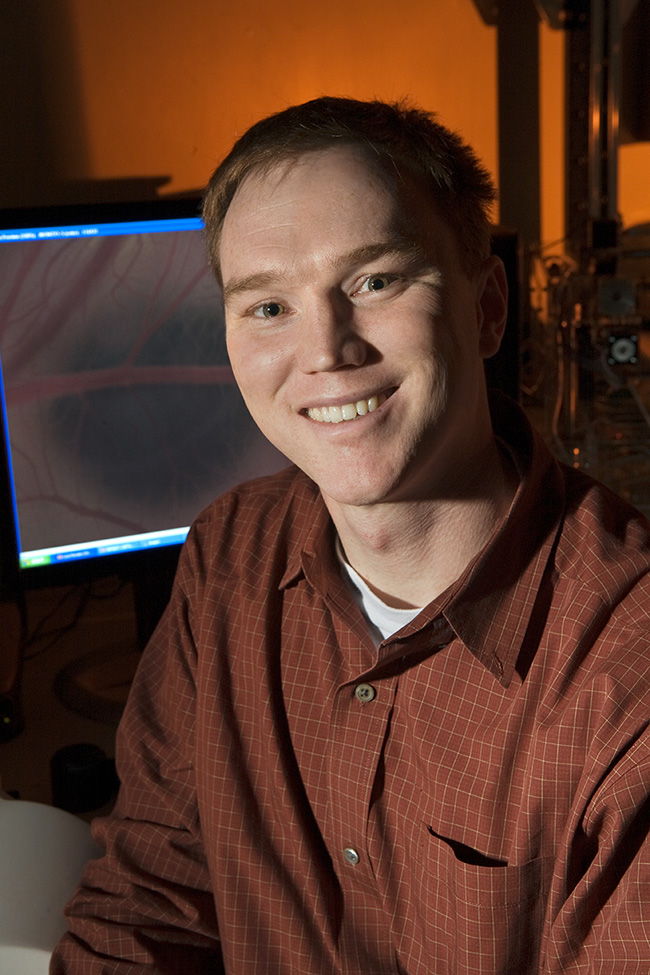Patented biomedical implant could improve heart patient outcome
By Tom Fleischman

Over the course of a year, the average person’s heart will beat nearly 40 million times. Stretched over a lifetime, that number often exceeds 2 billion.
That’s a lot of wear and tear on the valves, which regulate the one-way flow of blood through the body. Valve failure can cause blood to back up, which can lead to serious and sometimes fatal heart failure.
“If blood flows in a direction that it’s not supposed to at any point in the heart cycle, your heart has to pump more to get it moving in the right direction,” said Jonathan Butcher, associate professor and associate director of the Nancy E. and Peter C. Meinig School of Biomedical Engineering.
Butcher’s research themes involve understanding how the tissue in heart valves functions in normal health, how the valves get diseased, and how to deliver therapies that can keep the valves functioning longer before they need to be replaced. And one of Butcher’s latest projects involves an innovative procedure for when they do need replacing.
In April, Butcher and Christopher Frendl ’10, M.Eng. ’11, were awarded a patent for a biomedical implant for use in fluid shear stress environments, such as the heart. Since that time, Butcher has co-written a grant proposal for funding to take their implant idea further with a preclinical animal trial.
Their invention is a method for making a prosthetic heart valve more suited to the environment into which it’s placed. It’s both mechanical and biological – a “bio-hybridized” cell-coated prosthetic.
Current replacement heart valves are made either of treated animal tissue (pig, cow) or a combination of plastic and metal. The former is less durable than the latter and is well-suited for people over age 70, who typically are less active than younger people.
The problem with the latter: Since they are not biological materials, Butcher said, circulating blood components will adsorb onto the surfaces. That can cause clots, so the individual must take blood thinners. Lots of them.
“And those blood thinners basically eliminate you from military service, from being a policeman, a construction worker, basically any physically risky job. It also forces a lot of lifestyle changes that children and active people do not want,” he said.
That leaves younger patients with “basically no good option,” Butcher said, but his bio-hybridized approach could help change that. The invention for which he and Frendl earned a patent involves adding trenchlike niches to the prosthetic and filling them with living cells, which would help regulate normal function within the heart. The niche protects the cells from being swept away by the flow of blood.
“You add a living component to the prosthetic, and that living component hopefully naturally regulates coagulation, protein absorption and so on, so that those patients could maybe have far more reduced anti-coagulant drug treatment so that they can have a more normal life,” Butcher said. “You also eliminate those risks of mechanical failure that are incumbent with the bio-prosthetic [animal tissue] valves. You’re trying to get the best of both worlds.”
The grant that Butcher co-wrote with James Antaki, professor of biomedical engineering at Carnegie Mellon University - who will join the Cornell faculty in January 2018 - would help fund preclinical testing aimed at determining whether the bio-hybridization strategy needs to be different for left- and right-side valves. They will also conduct more in-depth study of clotting, as thrombosis is a specialty of Antaki’s.
Further study would likely involve testing the bio-hybridized implant in a pig since, as Butcher said, pigs and humans have very similar cardiovascular problems.
“Pigs are affected by cardiac surgery the same way as humans,” he said. “Like humans, they don’t tolerate anesthesia and bypass well and they have to recover in the hospital for days. Whereas sheep – which are a very prominent FDA model for cardiovascular work – come off bypass surgery and are walking around in an hour. That’s a little unrealistic for humans.”
The patented method was described in a 2014 paper in the journal Biomaterials. Support for the research came from the National Institutes of Health and the Cornell University Engineering Learning Initiatives. Some of the work was performed at the Cornell NanoScale Science and Technology Facility, which is supported by the National Science Foundation.
Media Contact
Get Cornell news delivered right to your inbox.
Subscribe